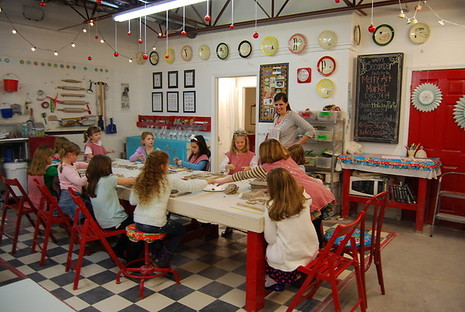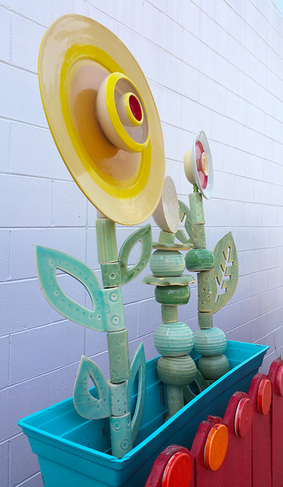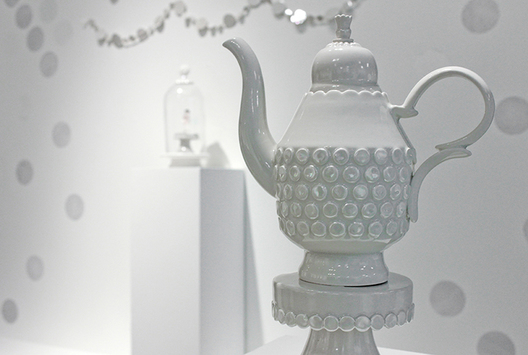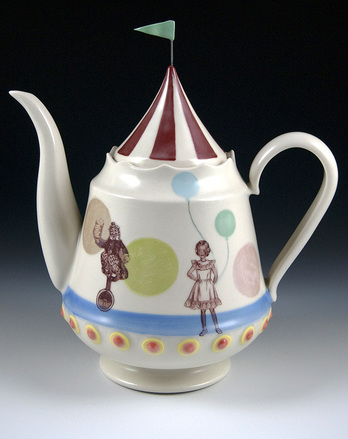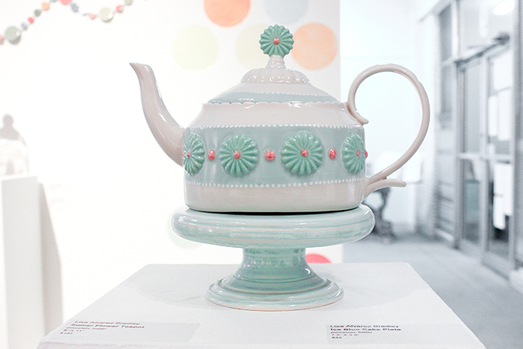|
This month we’re kicking off our “Artist Spotlight” series. Each month we will sit down with a local ceramic artist in Savannah just to discuss “clay things.” Our goal is to find out how and why they create and share that with our Community. For the month of November, we feature ceramic artist Lisa Bradley, the owner of Savannah’s Clay Spot. Before diving into the questions we had prepared for her, let’s get a little bit of Lisa’s background.
When asked in college what her ideal job would be, she knew it was teaching ceramics. Lisa discovered though, that she could still teach by obtaining her BFA in Ceramics, so she switched majors. In the clay program at Kent, she had the opportunity to work with two well-known professionals in ceramics, Kirk Mangus and Eva Kwong. It just so happened that Kirk was on sabbatical, so Lisa spent a lot of time working with Eva. What Lisa was looking for in her work was shiny, candy coated surfaces, but she was exposed to wood, salt and high fire surfaces. She says at that time, “Everything was brown and round.” Lisa was encouraged to use a lot of colored slips to achieve color, but slips are very thick and leave texture with every stroke you apply. She kept looking at the manufactured ceramics world, and all she saw was bright color without the texture. So, she kept pushing her professors and asking, “How can I get color?” They kept pointing her in different directions; for instance, suggesting she try maiolica. Lisa says, “Well, I tried maiolica, and it wasn't right. I just wanted intense bright color.”
Close to when Lisa was preparing to graduate, a wonderful graduate student introduced Lisa to underglazes, which was the color Lisa had been searching for. Lisa went back to her professors and asked why they never told her about underglazes. They said, “Well you have to go buy those. Why would you ever want to spend the money on buying things when you have a fully stocked glaze kitchen right here?” But Lisa didn’t care about the additional expense, she just wanted the color.
Now, let's move on to the interview. We wanted to ask Lisa questions that many clay artists face during their careers. The questions are not necessarily easy to answer, but with all of Lisa's experience, we couldn't resist. Why do you make functional ceramics? I love 2-D work, but I also like to interact with work. Consider the security guards at museums. They are always scolding people, and taking away half of the experience. You can only just look at the artwork. With 3-D, I like the tactile nature, and not only appreciate it as an art form, but I actually use it in my everyday routines. What's your opinion on the craft vs. fine art mentality? It all goes back to vocabulary. When people think of the word "ceramic," some may think of slip casted ware, but it all depends on who you’re talking to. Some people have a mental image of what a certain word means and each person has their own definition of art, high art and craft. Mass marketing is a downer for the word craft. When people think of craft, they may think of popsicle sticks and Michael’s. While there’s nothing wrong with popsicle sticks or Michaels, what most people know as craft is the way pop culture defines it. So, it all stems back into educating your community, and why it’s important for all of us to not only make our work, but to be community citizens educating others, so they know the definition between getting a kit at Michaels and what we’re doing here. Why are the ceramic arts important in Savannah? They are important because this is the environment that we live in, and we want to reach each individual, even those who may not want to make things in clay. As artists, we need to educate people on our craft, so that they will appreciate it and want to own it to use in their daily routines. It’s a continuous circle; if those people are owning and appreciating our things, it keeps us motivated to create, so that we can pay our bills and make a living. As an educator, what is the most important aspect of clay that you want to impart to your students? We all have to remember that the one quality you need with clay is patience. I reinstill in my students all the time that you have to be patient with yourself. Clay is a very step oriented process, and there can be bumps and bruises along the way. This is something which new students coming into the studio may not realize. They believe they can just make something one day, and the next time they visit, it will be waiting for them to take home and use, but that's not the case. Learning the patience and steps/stages of the craft is the key.
When you consider a space for installing your work, what are your thought processes and how do you envision displaying your work? There’s the vision, and then there’s the reality. So I try to blend the two. I’m constantly having to rethink my tactic towards installing for reality. For instance at one gallery, I wanted to show my work on the walls, but they didn’t allow nails in the wall–everything was hung by crown molding. It didn’t stop me from making work that was going to go on the wall, but I had to rethink how I was going to make those pieces, so they could be suspended from a wire. Like a picture, but still be three dimensional sculptures hanging on the wall. How do you make a living in clay? I make my living off of teaching classes. I think you can make a living as an artist or being an instructor, but it all depends on what path you want to go down. It’s hard work in each of those avenues, but you have to decide what makes you the happiest. I work a full 8 hours a day teaching at the studio, and I have to supplement my extra time making in the studio. I could make my living as a pottery artist, but in order to do that, I would lose some aspects of quality in my style of work, and I don’t want to let that go. So when making my work, I’m making it for myself; so that even if it never sells, I’m happy with it being in my life and handed down to my family. So I make my work for myself, and if I can sell it, great; but I’ve chosen to make my living from educating others. How do you price your work? Pricing is really, really hard, and I struggle with it, but the end result is that I price my work at market value. I know that my prices should be double what they are according to the cost and time it takes to make, but at the same time, if I want to make room for more pieces in my life, I’ve gotta let go. Some of my mugs and bowls are $28, but a teapot is somewhere like $150. Let’s talk about your craftsmanship/attention to detail? What’s the driving force behind your method of making? How do you accept things that don’t work out in the kiln? As you gain knowledge, you learn about the many shortcuts in clay. With that being said, someone once told me a story about the 100 year old pot on the shelf. I always think with every piece, if this sells and it's going to be sitting on a shelf for 100 years, is the 5, 10, 15 hour shortcut worth 100 years of living on this earth? And my answer is no, I don’t take shortcuts. I think it’s disappointing when I do see people take shortcuts–I understand it completely, but it's still sad. For instance production potters need to crank out the work to meet the needs of the masses, but when they don’t trim, I think it devalues the work. I try to give each surface attention–the bottom is just as refined as the top. I just think about that 100 year old pot, and 5 minutes is nothing compared to that time. What is the determining factor on your decision to keep a pot or break it? The defects are what make me throw away pieces–when somewhere along the making process, things didn’t go right. So for instance if I pull a pot out of the kiln and the glaze crazed, it might be an awesome piece, but in my book it’s ruined because the glaze has made the piece non-functional. How do you balance making work that is important to you versus work that the community responds to and buys? I’ve let people’s requests go. For instance, people want salt cellars, but I may not be necessarily interested in making those. So I’ll leave that to the people who are interested in making them. I’ve become sort of selfish, and I think that’s what forfeiting making your work for a living allows you to do. I’ve made the choice to make my living from instruction, so I don’t have the pressure to go into the studio and produce 100 salt cellars that I’m really not that excited about making in the first place. I feel that when you’re really not interested in producing something, it shows in your work. Maybe it's that there's a lack of attention to detail because your heart’s not invested. So with people's requests, I guess you could say, I kinda just take it all with a grain of salt. How do you balance family, business and studio life? I forfeit sleep. So no eight hours a night for you? Probably not. What handmade cup in your kitchen cabinet is currently your favorite? All of my favorites have broken. Right now the cup that I go for is one where I don’t even know the name of the artist. I got it at NCECA in Seattle from a local shop. It’s soda fired, and so not anything that I’m interested in making, but I like it for an everyday cup. It’s a one finger handle, and there are flaws in it. It looks like he trimmed it a little to thin on the bottom . . . and I’m saying he, like I know it was a guy who made it, but it is a little more masculine, so that’s why I’m saying that. He trimmed it way too much, and you can lift it up and see light coming through the bottom. But all my favorites have hit the dust, and when I think about those cups, I miss them. The funny thing is that they've all bit the dust when I’ve had too many things in my hand trying to open up the door . . . every time. We hope that you've enjoyed getting to know one of our own prominent artists in Savannah. Lisa's artist page will be coming soon to the Savannah Clay Community website, but to gain more insights from her, consider signing up for one of her classes at Savannah's Clay Spot. She has several classes that are perfect if you're interested in making gifts for the holidays.
0 Comments
Leave a Reply. |
